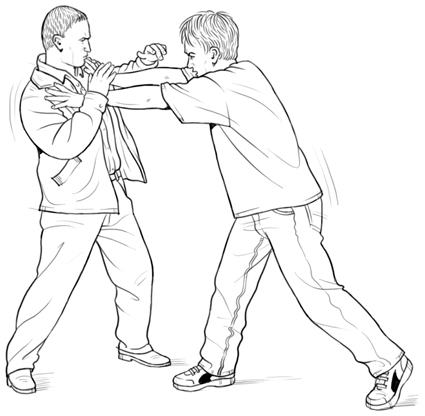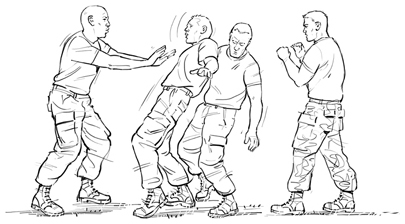
Pushing someone is unlikely to end a confrontational situation, but it can be used to gain an advantage or to create space for an escape. From a fence position you might try to deter an aggressor by pushing him away and warning him to keep his distance, but you should only try this once. If he doesn’t take the hint, he means business and a robust response is in order.

A push can be followed up with a psychological gambit, such as barking an order to leave you alone, or it can be used to make space for a strike.
One-Handed Pushing
A one-handed push is executed by placing your lead hand in the centre of the aggressor’s sternum, with your arm slightly bent. Do not lean and push with a straight arm; instead you snap your arm straight and throw your weight into the push, driving the opponent sharply backwards.
Two-Handed Pushing
A two-handed push targets the shoulders of the aggressor, tipping him backwards with a sharp two-handed shove. Again, it is important to throw your weight into the push and to execute it sharply rather than leaning and pushing steadily.

You should never just turn and run away from someone who is right in front of you – you’ll be caught. A push can make enough space to escape.
Be Aware of What’s Around You
If you can shove someone away and get through a door that can be locked or jammed shut, then this is an effective escape. A barrier such as a table or shop counter can be used the same way as a fence posture. The opposite also applies – fleeing into a dead end or allowing yourself to become cornered can place you in grave danger.
It may be possible to break contact with an aggressor and hide, or to reach a place that is full of people. Do not forget that people, including the aggressor and anyone with him, are part of the environment. If you can push one opponent into another you might prevent both of them doing anything against you for a moment. If you can cause an aggressor to become entangled with bystanders, then this could put him out of the fight.
The environment can also be used directly against an opponent. Pushing is more effective if the opponent trips over something or is slammed into the edge of a table. A bag you are carrying can be tossed in front of a rushing aggressor. He may trip, but even if he does not you will have an opportunity to escape or strike him while he regains his equilibrium.